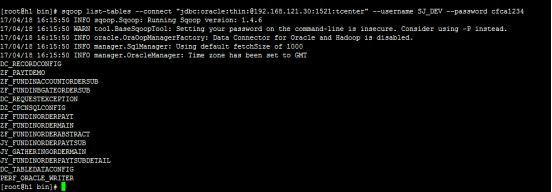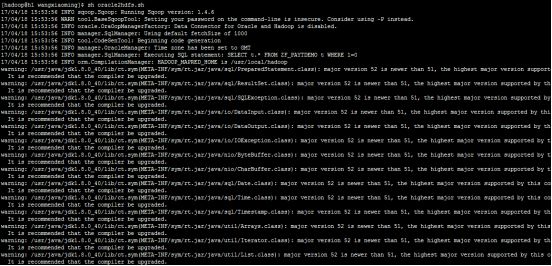【大数据】ETL工具 Sqoop Linux 环境下安装与基本使用
Sqoop Linux 环境下安装与基本使用
Sqoop安装部署
Sqoop的安装和配置十分简单, 需要linux和Hadoop环境支撑,下面将linux系统进行介绍.所有安装均采用源码安装方式。
系统要求
Linux
JDK(1.8)
Hadoop(目前使用2.7.3)
安装Sqoop
1. 下载
http://www-eu.apache.org/dist/sqoop/1.4.6/
解压:
tar –zxvf sqoop-1.4.6.bin__hadoop-2.0.4-alpha.tar.gz
移动:
mv sqoop-1.4.6.bin__hadoop-2.0.4/ sqoop1
2. 修改配置
vim /etc/profile
增加两行:
export SQOOP_HOME=/usr/local/sqoop1
export PATH=$PATH:$SQOOP_HOME/bin
执行:
source /etc/profile
3. 注释sqoop1/bin/confiure-sqoop HBase,Hive Zookeeper
注释后confiure-sqoop如下所示:
#!/bin/bash
#
# Copyright 2011 The Apache Software Foundation
#
# Licensed to the Apache Software Foundation (ASF) under one
# or more contributor license agreements. See the NOTICE file
# distributed with this work for additional information
# regarding copyright ownership. The ASF licenses this file
# to you under the Apache License, Version 2.0 (the
# "License"); you may not use this file except in compliance
# with the License. You may obtain a copy of the License at
#
# http://www.apache.org/licenses/LICENSE-2.0
#
# Unless required by applicable law or agreed to in writing, software
# distributed under the License is distributed on an "AS IS" BASIS,
# WITHOUT WARRANTIES OR CONDITIONS OF ANY KIND, either express or implied.
# See the License for the specific language governing permissions and
# limitations under the License.
# This is sourced in by bin/sqoop to set environment variables prior to
# invoking Hadoop.
bin="$1"
if [ -z "${bin}" ]; then
bin=`dirname $0`
bin=`cd ${bin} && pwd`
fi
if [ -z "$SQOOP_HOME" ]; then
export SQOOP_HOME=${bin}/..
fi
SQOOP_CONF_DIR=${SQOOP_CONF_DIR:-${SQOOP_HOME}/conf}
if [ -f "${SQOOP_CONF_DIR}/sqoop-env.sh" ]; then
. "${SQOOP_CONF_DIR}/sqoop-env.sh"
fi
# Find paths to our dependency systems. If they are unset, use CDH defaults.
if [ -z "${HADOOP_COMMON_HOME}" ]; then
if [ -n "${HADOOP_HOME}" ]; then
HADOOP_COMMON_HOME=${HADOOP_HOME}
else
if [ -d "/usr/lib/hadoop" ]; then
HADOOP_COMMON_HOME=/usr/lib/hadoop
else
HADOOP_COMMON_HOME=${SQOOP_HOME}/../hadoop
fi
fi
fi
if [ -z "${HADOOP_MAPRED_HOME}" ]; then
HADOOP_MAPRED_HOME=/usr/lib/hadoop-mapreduce
if [ ! -d "${HADOOP_MAPRED_HOME}" ]; then
if [ -n "${HADOOP_HOME}" ]; then
HADOOP_MAPRED_HOME=${HADOOP_HOME}
else
HADOOP_MAPRED_HOME=${SQOOP_HOME}/../hadoop-mapreduce
fi
fi
fi
# We are setting HADOOP_HOME to HADOOP_COMMON_HOME if it is not set
# so that hcat script works correctly on BigTop
if [ -z "${HADOOP_HOME}" ]; then
if [ -n "${HADOOP_COMMON_HOME}" ]; then
HADOOP_HOME=${HADOOP_COMMON_HOME}
export HADOOP_HOME
fi
fi
#if [ -z "${HBASE_HOME}" ]; then
# if [ -d "/usr/lib/hbase" ]; then
# HBASE_HOME=/usr/lib/hbase
# else
# HBASE_HOME=${SQOOP_HOME}/../hbase
# fi
#fi
#if [ -z "${HCAT_HOME}" ]; then
# if [ -d "/usr/lib/hive-hcatalog" ]; then
# HCAT_HOME=/usr/lib/hive-hcatalog
# elif [ -d "/usr/lib/hcatalog" ]; then
# HCAT_HOME=/usr/lib/hcatalog
# else
# HCAT_HOME=${SQOOP_HOME}/../hive-hcatalog
# if [ ! -d ${HCAT_HOME} ]; then
# HCAT_HOME=${SQOOP_HOME}/../hcatalog
# fi
# fi
#fi
if [ -z "${ACCUMULO_HOME}" ]; then
if [ -d "/usr/lib/accumulo" ]; then
ACCUMULO_HOME=/usr/lib/accumulo
else
ACCUMULO_HOME=${SQOOP_HOME}/../accumulo
fi
fi
#if [ -z "${ZOOKEEPER_HOME}" ]; then
# if [ -d "/usr/lib/zookeeper" ]; then
# ZOOKEEPER_HOME=/usr/lib/zookeeper
# else
# ZOOKEEPER_HOME=${SQOOP_HOME}/../zookeeper
# fi
#fi
#if [ -z "${HIVE_HOME}" ]; then
# if [ -d "/usr/lib/hive" ]; then
# export HIVE_HOME=/usr/lib/hive
# elif [ -d ${SQOOP_HOME}/../hive ]; then
# export HIVE_HOME=${SQOOP_HOME}/../hive
# fi
#fi
# Check: If we can't find our dependencies, give up here.
if [ ! -d "${HADOOP_COMMON_HOME}" ]; then
echo "Error: $HADOOP_COMMON_HOME does not exist!"
echo 'Please set $HADOOP_COMMON_HOME to the root of your Hadoop installation.'
exit 1
fi
if [ ! -d "${HADOOP_MAPRED_HOME}" ]; then
echo "Error: $HADOOP_MAPRED_HOME does not exist!"
echo 'Please set $HADOOP_MAPRED_HOME to the root of your Hadoop MapReduce installation.'
exit 1
fi
## Moved to be a runtime check in sqoop.
#if [ ! -d "${HBASE_HOME}" ]; then
# echo "Warning: $HBASE_HOME does not exist! HBase imports will fail."
# echo 'Please set $HBASE_HOME to the root of your HBase installation.'
#fi
## Moved to be a runtime check in sqoop.
#if [ ! -d "${HCAT_HOME}" ]; then
# echo "Warning: $HCAT_HOME does not exist! HCatalog jobs will fail."
# echo 'Please set $HCAT_HOME to the root of your HCatalog installation.'
#fi
#if [ ! -d "${ACCUMULO_HOME}" ]; then
# echo "Warning: $ACCUMULO_HOME does not exist! Accumulo imports will fail."
# echo 'Please set $ACCUMULO_HOME to the root of your Accumulo installation.'
#fi
#if [ ! -d "${ZOOKEEPER_HOME}" ]; then
# echo "Warning: $ZOOKEEPER_HOME does not exist! Accumulo imports will fail."
# echo 'Please set $ZOOKEEPER_HOME to the root of your Zookeeper installation.'
#fi
# Where to find the main Sqoop jar
SQOOP_JAR_DIR=$SQOOP_HOME
# If there's a "build" subdir, override with this, so we use
# the newly-compiled copy.
if [ -d "$SQOOP_JAR_DIR/build" ]; then
SQOOP_JAR_DIR="${SQOOP_JAR_DIR}/build"
fi
function add_to_classpath() {
dir=$1
for f in $dir/*.jar; do
SQOOP_CLASSPATH=${SQOOP_CLASSPATH}:$f;
done
export SQOOP_CLASSPATH
}
# Add sqoop dependencies to classpath.
SQOOP_CLASSPATH=""
if [ -d "$SQOOP_HOME/lib" ]; then
add_to_classpath $SQOOP_HOME/lib
fi
# Add HBase to dependency list
#if [ -e "$HBASE_HOME/bin/hbase" ]; then
# TMP_SQOOP_CLASSPATH=${SQOOP_CLASSPATH}:`$HBASE_HOME/bin/hbase classpath`
# SQOOP_CLASSPATH=${TMP_SQOOP_CLASSPATH}
#fi
# Add HCatalog to dependency list
#if [ -e "${HCAT_HOME}/bin/hcat" ]; then
# TMP_SQOOP_CLASSPATH=${SQOOP_CLASSPATH}:`${HCAT_HOME}/bin/hcat -classpath`
# if [ -z "${HIVE_CONF_DIR}" ]; then
# TMP_SQOOP_CLASSPATH=${TMP_SQOOP_CLASSPATH}:${HIVE_CONF_DIR}
# fi
# SQOOP_CLASSPATH=${TMP_SQOOP_CLASSPATH}
#fi
# Add Accumulo to dependency list
if [ -e "$ACCUMULO_HOME/bin/accumulo" ]; then
for jn in `$ACCUMULO_HOME/bin/accumulo classpath | grep file:.*accumulo.*jar | cut -d':' -f2`; do
SQOOP_CLASSPATH=$SQOOP_CLASSPATH:$jn
done
for jn in `$ACCUMULO_HOME/bin/accumulo classpath | grep file:.*zookeeper.*jar | cut -d':' -f2`; do
SQOOP_CLASSPATH=$SQOOP_CLASSPATH:$jn
done
fi
#ZOOCFGDIR=${ZOOCFGDIR:-/etc/zookeeper}
#if [ -d "${ZOOCFGDIR}" ]; then
# SQOOP_CLASSPATH=$ZOOCFGDIR:$SQOOP_CLASSPATH
#fi
SQOOP_CLASSPATH=${SQOOP_CONF_DIR}:${SQOOP_CLASSPATH}
# If there's a build subdir, use Ivy-retrieved dependencies too.
if [ -d "$SQOOP_HOME/build/ivy/lib/sqoop" ]; then
for f in $SQOOP_HOME/build/ivy/lib/sqoop/*/*.jar; do
SQOOP_CLASSPATH=${SQOOP_CLASSPATH}:$f;
done
fi
add_to_classpath ${SQOOP_JAR_DIR}
HADOOP_CLASSPATH="${SQOOP_CLASSPATH}:${HADOOP_CLASSPATH}"
if [ ! -z "$SQOOP_USER_CLASSPATH" ]; then
# User has elements to prepend to the classpath, forcibly overriding
# Sqoop's own lib directories.
export HADOOP_CLASSPATH="${SQOOP_USER_CLASSPATH}:${HADOOP_CLASSPATH}"
fi
export SQOOP_CLASSPATH
export SQOOP_CONF_DIR
export SQOOP_JAR_DIR
export HADOOP_CLASSPATH
export HADOOP_COMMON_HOME
export HADOOP_MAPRED_HOME
#export HBASE_HOME
#export HCAT_HOME
#export HIVE_CONF_DIR
#export ACCUMULO_HOME
#export ZOOKEEPER_HOME
4. 将驱动添加到sqoop/lib中
Sqoop测试运行实例
测试是否连接oracle:
执行命令:
sqoop list-tables --connect "jdbc:oracle:thin:@192.168.121.30:1521:tcenter" --username SJ_DEV --password cfca1234
结果显示如下:
测试将Oracle 数据导出到HDFS
准备脚本oracle2hdfs.sh:
CONNECTURL=jdbc:oracle:thin:@192.168.121.30:1521:tcenter
#oracle username
ORANAME=SJ_DEV
#oracle password
ORAPWD=cfca1234
#table name
oracleTableName=ZF_PAYTDEMO
#orafilename
oraTName=ZF_PAYTDEMO
columns=Systemno
#hdfs
hdfsPath=/user/wangxiaoming/$oraTName 执行命令
sqoop import --append --connect $CONNECTURL --username $ORANAME --password $ORAPWD --target-dir $hdfsPath --num-mappers 1 --table $oracleTableName --columns $columns --fields-terminated-by '\001'
查看执行结果:
查看HDFS文件系统是否有文件:
执行命令:
Hadoop fs -ls /user/wangxiaoming/ZF_PAYTDEMO
查看文件,执行命令:
Hadoop fs –cat /user/wangxiaoming/ZF_PAYTDEMO/part-m-0000000



